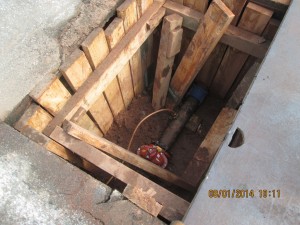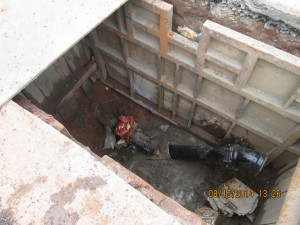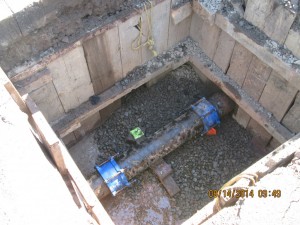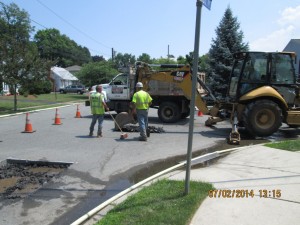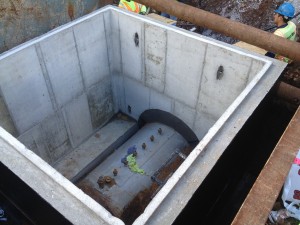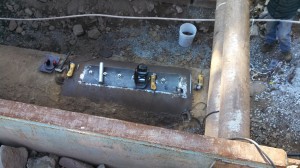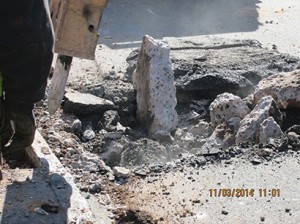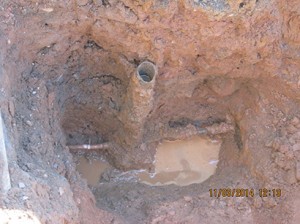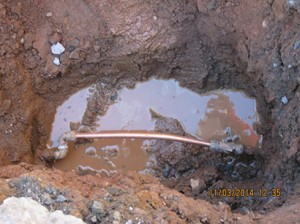To get more specific information about individual projects and see which are most likely to impact your neighborhood, view the details listed under each major Capital Improvement Project (CIP) category below.
Cleaning and Lining of Cast Iron Water Mains
2014-2015
Clifton and North Arlington, New Jersey
NOTICE TO CLIFTON & NORTH ARLINGTON CUSTOMERS
Passaic Valley Water Commission is committed to providing our customers with high quality water and service. As part of our on-going improvement program, we are cleaning, lining, testing and disinfecting approximately 14,900 linear feet of 6 and 8-inch diameter water mains in Clifton along Greglawn Drive, Staudtmauer Drive, Avondale Avenue, Greenlawn Avenue, Broadale Avenue, Friar Lane, Weeks Court, Graydon Terrace, Albury Road, Notch Road and Broad Street. Work will begin on or around August 25th and will be completed by December 2015.
Starting around September 8th we will start cleaning, lining, testing and disinfecting approximately 2,600 linear feet of 6-inch diameter water mains in North Arlington along Bond Place, Belmont Avenue, Union Place, Renner Place, and Stratford Place. Work will be completed by December 2015.
Included with the Work, but not limited to, are the following:
- Saw-cut existing paving and excavate to expose piping. Complete all cuts into the existing mains as required for equipment access and bypass piping.
- Furnish and install new valves to replace all existing main line valves along mains being cleaned and lined unless otherwise directed by the Owner.
- Furnish and install new valves on the main line or to replace leaking or inoperative valves on adjacent streets (“sideline” valves) as required and as directed by the Owner.
- Furnish and install line stops and new valves if unable to isolate transmission mains from mains to be cleaned and lined where existing in-line valves are inoperable.
- Furnish, install, test, disinfect, maintain, protect and remove bypass piping of sufficient diameter and strength to maintain the service flow conditions specified and required throughout the construction period.
- Backfill of trenches and placement of temporary paving.
- Furnish services of an independent consultant to measure the actual Hazen-Williams “C” factor upon completion of the cleaning and lining operation.
- Video-inspect completed mains in locations directed by Owner.
- Complete restoration and cleanup in all areas disturbed by construction.
PLEASE WATCH YOUR STEP
Our Contractor must dig in the street in order to clean and line water mains and replace gate valves. Temporary mains will also be run along the curb. Please watch your step and ask your children not to play in the work areas.
INCONVENIENCE IS TEMPORARY – IMPROVEMENT IS PERMANENT
We understand that this project may cause some inconvenience. We will make every effort to minimize the disturbance and will work closely with local police and officials to reduce traffic problems.
IF YOU HAVE ANY CONCERNS
Please call our customer service number at (973) 340-4300 during regular working hours. During off hours and on the weekends, please call our contractor’s emergency contact number at 201-983-2299.
Thank you for your patience and cooperation. These improvements will help us to continue to give you dependable water service.
Furnish and deliver portable corrosion
inhibitor system
2014
Great Notch Reservoir
Woodland Park, New Jersey
Under the Contract, the CONTRACTOR shall assemble, factory test, deliver, install and field test a portable corrosion inhibitor feed system. The system shall have the capability to store a minimum of 1,650 gallons of chemical and pump to two separate feed points, each controlled by an independent control loop run through a PLC.
LEAD SERVICE LINE RENEWAL PROGRAM – 2014
Clifton, Passaic, Paterson and Prospect Park
Replace existing lead service lines from the water main to curb stop where the service line from curb to building is currently copper. A typical service line renewal project will include the sawcutting of the asphalt pavement, concrete sidewalk and curb, removing and disposing of pavement, excavating to expose the existing service line and curb stop, shutting off the existing corporation at the main, cutting the pipe at the customer side of the curb stop and at the corporation on the main, removing and disposing of the existing curb box, curb stop and service line, installing a new curb stop and a new copper service line from the existing corporation at the water main to the customer’s meter at the building for full renewals, opening of the existing corporation and new curb stop to test for leaks and to confirm customer has service, installing new curb box to grade, backfilling with and compacting quarry process stone to required depth, and placing temporary pavement (supplied by PVWC). Place temporary pavement in disturbed concrete or asphalt sidewalk areas. In grass areas, the trench shall be backfilled with quarry process and the top 12 inches shall be replaced with topsoil, seed, and hay. Final pavement restoration will be conducted under the Pavement and Sidewalk Replacement Contract.
SODIUM HYDROXIDE TANK REPLACEMENT
Little Falls Plant Totowa, New Jersey The OWNER stores Sodium Hydroxide, approximately 50% solution strength, in six (6) existing 15,000 gallon, panel heated and jacket insulated fiberglass storage tanks at the Little Falls Water Treatment Plant (LFWTP) facility in Totowa, New Jersey. Under the Contract, the CONTRACTOR shall, when ordered by the OWNER, sequentially furnish and install new stress-relieved carbon steel tanks of the same nominal capacity, height and diameter of the existing tanks, and with the same configurations, arrangements, sizes, locations, and tank connections for piping, instrumentation, etc. Dimensions, drilling, and gasket patterns of tank connections shall match those of the existing tank connections that are being replaced. Include sequential removal and replacement of the existing roof access covers. Following installation of each new tank, properly replace and secure each existing roof access cover so as to ensure a weather-tight seal.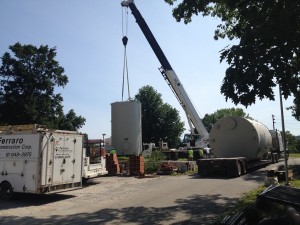
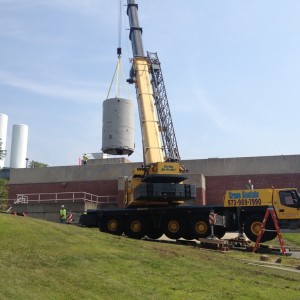
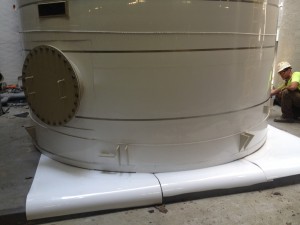
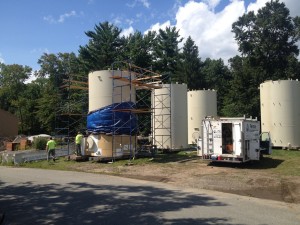
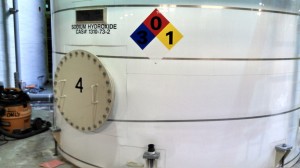
Water Storage Improvement Feasibility Project 2014
The requirement to cover open distribution reservoirs is in the National Primary Drinking Water Regulations and can be found at 40 CFR 141.417. All uncovered reservoirs must be covered or provided with treatment. If a treatment technique is employed, the systems must treat the water withdrawn from the reservoir and sent to the distribution system to achieve inactivation and/or removal of at least 4-log virus, 3-log Giardia lamblia, and 2-log Cryptosporidium using a protocol approved by the State.
The basis for the requirements of the rule is sound. In addition to being a security risk, the American Water Works Association has justified their support of the rule as follows:
“Uncovered storage reservoirs provide the greatest opportunity for contaminant entry into the distribution system. These reservoirs are potentially subject to contamination from bird and other animal excrement that can potentially transmit disease-causing organisms to the finished water. Microorganisms can also be introduced into open reservoirs from windblown dust, debris and algae. Algae proliferate in open reservoirs with adequate sunlight and nutrients and impart color, taste and odor to the water on a seasonal basis. Organic matter such as leaves and pollen are also a concern in open reservoirs. Waterfowl are known carriers of many different waterborne pathogens and have the ability to disseminate these pathogens over a wide area. For example, Vibrio cholera has been isolated from feces of 20 species of aquatic birds in Colorado and Utah (Ogg, Ryder and Smith 1989). Waterfowl are known carriers of S. Montevideo B, Vibriocholera and Hepatitis A virus (Brock 1979) and E. coli, Norwalk virus, Coronavirus, Coxsackieviruses, Rotavirus, Astrovirus, and Cryptosporidium (WRc and Public Health Laboratory Service 1977).” In addition to these issues cited by AWWA, open reservoirs also allow residual disinfectants to dissipate and contribute to changes in water quality (e.g. changes in pH) that can adversely affect the stability of the water distributed to customers. Low pH water distributed from open reservoirs can contribute to increased corrosion within the distribution system leading to increased levels of lead, copper and iron in the finished water as well as shortened service lives for water mains, valves and service lines.
Uncovered finished water reservoirs used to be a common feature of many water systems but their numbers have dwindled, i.e.,
Uncovered finished water reservoirs used to be a common feature of many water systems but their numbers have dwindled, i.e.,
- In the mid-1970’s EPA reported the existence of approximately 750 uncovered distribution reservoirs;
- By 1998, the number of uncovered reservoirs remaining in service had declined to 300;
- By 2000, the number in service had declined to 141;
- By 2006, only 81 remained in service; and
- As of the end of 2011, 38 remain in service and of these 10 have remedial projects under construction. The remaining 28 are all addressed by some form of compliance schedule or administrative consent decree.
Of the 38 open reservoirs that remain in service, covers or treatment are being installed on 10. This leaves 28 that are the subject of compliance schedules. The following table shows the location of the last 28 by State.
| State | Number |
| New York | 9 |
| California | 6 |
| New Jersey | 5 |
| Maryland | 3 |
| Oregon | 3 |
| Washington | 2 |
The Commission’s three uncovered finished water reservoirs (Great Notch, New Street, and Levine) are presently not in conformance with USEPA and NJDEP guidelines for finished water storage as defined in CFR 141.74(c)(1) and (c)(2). The Commission has entered into an Administrative Consent Order (ACO) with the New Jersey Department of Environmental Protection (NJDEP) to eliminate the three reservoirs.
Proposed Plan
The Commission retained a professional engineering consultant to prepare a feasibility study and conceptual design report that evaluated several alternatives for eliminating the reservoirs. From 2009 through 2011, the Commission and our consultant worked with the NJDEP to develop a plan that would meet the drinking water requirements in the most cost effective and least disruptive manner. The Executive Summary of the Feasibility Report presents a summary of the report and can be accessed by clicking here. Eight specific alternatives were developed during the feasibility study and analyzed in detail.
The proposed plan has been divided into three phases which the Commission envisions will be implemented over the next 8 to 10 years. Phase 1 is presently being designed now (2013 to 2014) and is planned for construction in the middle of 2015. A detailed summary of the Phase 1 project can be accessed by clicking here. The key components of all three phases are as follows:
Phase 1
- Emergency back-up power facilities at the Commission’s Little Falls Water Treatment Plant located in Totowa, New Jersey. This work will include four 3,000 kW generators as well as improvements to the plant’s transformers and switchgear.
- Two 2.5 million gallon prestressed concrete water storage tanks located within the footprint of the existing Levine Reservoir in Paterson, New Jersey.
- A 2 million gallon steel water storage tank located adjacent to the existing Verona Water Storage Tank in Verona, New Jersey.
Phase 2
- Two 15 million gallon prestressed concrete water storage tanks located within the footprint of the existing New Street Reservoir in Woodland Park, New Jersey. Demolition of the New Street Reservoir Dam is also included.
- Construction of new pumping station with a firm capacity of 8 million gallons per day adjacent to the existing New Street Reservoir. This pumping station will transfer water to the Great Notch Reservoir and ultimately to the proposed storage tanks at the Great Notch Reservoir. It will also provide redundancy to the Great Notch Pumping station and deliver water to this pumping station while it is being expanded under Phase 3.
Phase 3
- Two 20 million gallon prestressed concrete water storage tanks located within the footprint of the existing Great Notch Reservoir in Woodland Park, New Jersey. Demolition of the Great Notch Reservoir Dam is also included.
- Expansion of the Great Notch Reservoir Pumping Station from 6 to 12 million gallons per day firm capacity.
Public Outreach
Working with PVWC, JGSC Group designed a plan to reach out to the public and solicit information on their preferences about the project and alternative ideas and suggestions.
- PVWC held a series of 6 public meetings between February and November 2014.
- JGSC held two public workshops (11/14/15 and 11/19/15)
- JGSC mailed informational brochures and postcards to 125,452 households in the area.
- JGSC went door-to-door to 3,741 households to hand distribute informational flyers and speak with residents in-person.
- JGSC and PVWC distributed informational flyers to another 4,500 households in the 07502 zip code.
- Tear-off pads were distributed to dozens of businesses within a 1/2 mile radius of the Levine Reservoir directing people to visit the PVWC website for more information. A total of 1,146 unique individuals visited the relevant webpages.
- JGSC mailed surveys to 125,452 households and made the survey available online. We received 4,897 responses and over 1,200 comments.
A detailed summary of the Public Outreach Findings can be accessed by clicking here.
Downloadables
- Public Outreach Findings Summary
- Resolution of Effects Meeting Agenda 6/5/2018
- Environmental Decision Document/Environmental Appraisal 08-01-2018
- Application for Project Authorization 06-21-2018
- Levine Tanks Approved Safe Drinking Water Construction Permit
- Levine Reservoir Phase IA Cultural Resource Survey July 2010 (1 of 2)
- Levine Reservoir Phase IA Cultural Resource Survey July 2010 (2 of 2)
- Levine Reservoir Public Notice 08-07-2018
Contact Us
Office Hours:
Monday-Friday
7:30 a.m. – 6:00 p.m.
Main Office:
Passaic Valley Water Commission
1525 Main Avenue
Clifton, NJ 07011
Telephone: 973-340-4300
Fax: 973-340-5598
Emergency:
By calling Customer Service 973-340-4300 at any time, day or night, Passaic Valley Water Commission will respond to water emergency situations for you.

